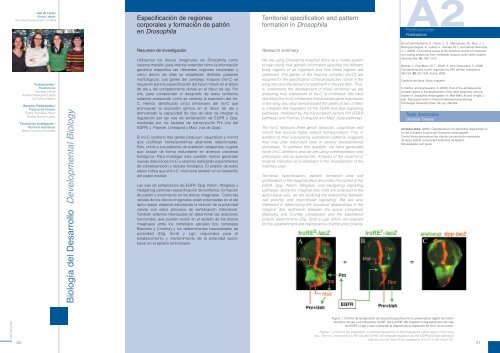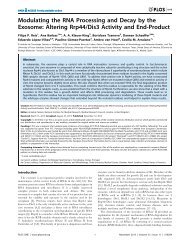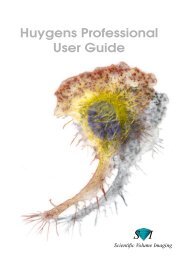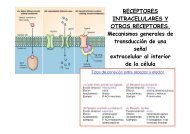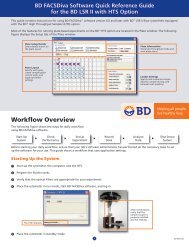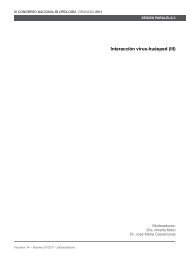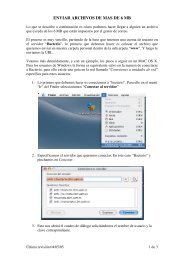Drosophila - Severo Ochoa - Universidad Autónoma de Madrid
Drosophila - Severo Ochoa - Universidad Autónoma de Madrid
Drosophila - Severo Ochoa - Universidad Autónoma de Madrid
Create successful ePaper yourself
Turn your PDF publications into a flip-book with our unique Google optimized e-Paper software.
Jefe <strong>de</strong> Línea /<br />
Group Lea<strong>de</strong>r:<br />
Sonsoles Campuzano Corrales<br />
Especificación <strong>de</strong> regiones<br />
corporales y formación <strong>de</strong> patrón<br />
en <strong>Drosophila</strong><br />
Territorial specification and pattern<br />
formation in <strong>Drosophila</strong><br />
A2<br />
Publicaciones<br />
Publications<br />
Postdoctorales /<br />
Postdoctoral:<br />
Annalisa Letizia<br />
Anabel Rodríguez-Learte<br />
Sol Sotillos Martín<br />
Becarios Predoctorales /<br />
Predoctoral Fellows:<br />
Esther González Pérez<br />
Natalia Barrios López<br />
Técnicos <strong>de</strong> Investigación /<br />
Technical Assistance:<br />
Nerea Cisneros González<br />
Biología <strong>de</strong>l Desarrollo Developmental Biology<br />
Resumen <strong>de</strong> investigación<br />
Utilizamos los discos imaginales <strong>de</strong> <strong>Drosophila</strong> como<br />
sistema mo<strong>de</strong>lo para intentar enten<strong>de</strong>r cómo la información<br />
genética especifica las diferentes regiones corporales y<br />
cómo <strong>de</strong>ntro <strong>de</strong> ellas se establecen distintos patrones<br />
morfológicos. Los genes <strong>de</strong>l complejo Iroquois (Iro-C) se<br />
requieren para la especificación <strong>de</strong>l futuro notum en el disco<br />
<strong>de</strong> ala y <strong>de</strong>l compartimento dorsal en el disco <strong>de</strong> ojo. Por<br />
ello, para compren<strong>de</strong>r el <strong>de</strong>sarrollo <strong>de</strong> estos territorios<br />
estamos analizando cómo se controla la expresión <strong>de</strong>l Iro-<br />
C. Hemos i<strong>de</strong>ntificado cinco enhancers <strong>de</strong>l Iro-C que<br />
promueven la expresión génica en el disco <strong>de</strong> ala y<br />
<strong>de</strong>mostrado la capacidad <strong>de</strong> dos <strong>de</strong> ellos <strong>de</strong> integrar la<br />
regulación por las vías <strong>de</strong> señalización <strong>de</strong> EGFR y Dpp,<br />
mediadas por los factores <strong>de</strong> transcripción Pnt (vía <strong>de</strong>l<br />
EGFR) y Pannier, U-shaped y Mad (vía <strong>de</strong> Dpp).<br />
El Iro-C contiene tres genes (araucan, caupolican y mirror)<br />
que codifican homeoproteínas altamente relacionadas.<br />
Esto, unido a sus patrones <strong>de</strong> expresión solapantes, sugiere<br />
que actúan <strong>de</strong> forma redundante en diversos procesos<br />
biológicos. Para investigar esta cuestión hemos generado<br />
nuevas <strong>de</strong>leciones Iro-C y estamos realizando experimentos<br />
<strong>de</strong> sobreexpresión y rescate fenotípico. El análisis <strong>de</strong> estos<br />
alelos indica que el Iro-C interviene también en el <strong>de</strong>sarrollo<br />
<strong>de</strong>l palpo maxilar.<br />
Las vías <strong>de</strong> señalización <strong>de</strong> EGFR, Dpp, Notch, Wingless y<br />
Hedgehog controlan especificación <strong>de</strong> territorios, formación<br />
<strong>de</strong> patrón y crecimiento en los discos imaginales. Como las<br />
células <strong>de</strong> los discos imaginales están polarizadas en el eje<br />
ápico-basal, estamos estudiando la relación <strong>de</strong> la polaridad<br />
celular con estos procesos <strong>de</strong> señalización intercelular.<br />
También estamos interesados en <strong>de</strong>terminar las relaciones<br />
funcionales que pue<strong>de</strong>n existir en el epitelio <strong>de</strong> los discos<br />
imaginales entre los complejos apicales (los complejos<br />
Bazooka y Crumbs) y los <strong>de</strong>terminantes basolaterales <strong>de</strong><br />
polaridad (Dlg, Scrib y Lgl), requeridos para el<br />
establecimiento y mantenimiento <strong>de</strong> la polaridad ápicobasal<br />
en el epitelio embrionario.<br />
Research summary<br />
We are using <strong>Drosophila</strong> imaginal discs as a mo<strong>de</strong>l system<br />
to help clarify how genetic information specifies the different<br />
body regions of an organism and how these regions are<br />
patterned. The genes of the Iroquois complex (Iro-C) are<br />
required for the specification of the prospective notum in the<br />
wing disc and the dorsal compartment in the eye disc. Thus,<br />
to un<strong>de</strong>rstand the <strong>de</strong>velopment of these territories we are<br />
analyzing how expression of Iro-C is controlled. We have<br />
i<strong>de</strong>ntified five Iro-C enhancers that promote gene expression<br />
in the wing disc and <strong>de</strong>monstrated the ability of two of them<br />
to integrate the regulation by the EGFR and Dpp signalling<br />
pathways, mediated by the transcription factors Pnt (EGFR<br />
pathway) and Pannier, U-shaped and Mad (Dpp pathway).<br />
The Iro-C harbours three genes (araucan, caupolican and<br />
mirror) that enco<strong>de</strong> highly related homeoproteins. This, in<br />
addition to their overlapping expression patterns, suggests<br />
they may play redundant roles in several <strong>de</strong>velopmental<br />
processes. To address this question, we have generated<br />
novel Iro-C <strong>de</strong>letions and we are using overexpression and<br />
phenotypic rescue approaches. Analysis of the novel Iro-C<br />
mutants indicates its involvement in the <strong>de</strong>velopment of the<br />
maxillary palp.<br />
Territorial specification, pattern formation and cell<br />
proliferation in the imaginal discs are un<strong>de</strong>r the control of the<br />
EGFR, Dpp, Notch, Wingless and Hedgehog signalling<br />
pathways. Since the imaginal disc cells are polarized in the<br />
apico-basal axis, we are studying the relationship between<br />
cell polarity and intercellular signalling. We are also<br />
interested in <strong>de</strong>termining the functional relationships in the<br />
imaginal disc epithelium between the apical complexes<br />
(Bazooka and Crumbs complexes) and the basolateral<br />
polarity <strong>de</strong>terminants (Dlg, Scrib y Lgl), which are required<br />
for the establishment and maintenance of embryonic polarity.<br />
De la Calle-Mustienes, E., Feijoo, C. G., Manzanares, M., Tena, J. J.,<br />
Rodriguez-Seguel, E., Letizia, A., Allen<strong>de</strong>, M. L. and Gómez-Skarmeta,<br />
J. L. (2005). A functional survey of the enhancer activity of conserved<br />
non-coding sequences from vertebrate Iroquois cluster gene <strong>de</strong>serts.<br />
Genome Res. 15, 1061-1072.<br />
Moscat, J., Diaz-Meco, M. T., Albert, A. and Campuzano, S. (2006).<br />
Cell signaling and fuction organized by PB1 domain interactions.<br />
Mol Cell. 23, 631- 640. Fecha: 2006.<br />
Capítulos <strong>de</strong> libros / Book chapters:<br />
S. Sotillos and Campuzano, S. (2005). Role of the achaete-scute<br />
complex genes in the <strong>de</strong>velopment of the adult peripheral nervous<br />
system of <strong>Drosophila</strong> melanogaster. In: Marí-Beffa, M and Knight,J<br />
(ed). Key Experiments in Practical Developmental Biology.<br />
Cambridge University Press, UK, pp. 296-309.<br />
Tesis doctorales<br />
Doctoral Theses<br />
Annalisa Letizia. (2005) Caracterización <strong>de</strong> elementos reguladores en<br />
cis <strong>de</strong>l Complejo Iroquois <strong>de</strong> <strong>Drosophila</strong> melanogaster:<br />
Control transcripcional por las vías <strong>de</strong> comunicación intercelular<br />
<strong>de</strong> Dpp y EGFR. <strong>Universidad</strong> Autónoma <strong>de</strong> <strong>Madrid</strong>.<br />
Sobresaliente cum lau<strong>de</strong>.<br />
CBM 2005/2006<br />
20<br />
Figura 1. Control <strong>de</strong> la expresión <strong>de</strong> araucan/caupolican en la presumptiva región <strong>de</strong> notum<br />
<strong>de</strong>l disco <strong>de</strong> ala. Los enhancers Iro-RE 2 (A) e Iro-RE 1 (B) integran la regulación por las vías<br />
<strong>de</strong> EGFR y Dpp y dan cuenta <strong>de</strong> la mayoría <strong>de</strong> la expresión <strong>de</strong> Iro-C en el notum.<br />
Figure 1. Control of the expression of araucan/caupolican in the prospective notum region of the wing<br />
disc. The Iro-C enhancers Iro-RE 2 (A) and Iro-RE 1 (B) integrate regulation by the EGFR and Dpp pathways<br />
and account for most of the expression of Iro-C in the notum (C).<br />
21


